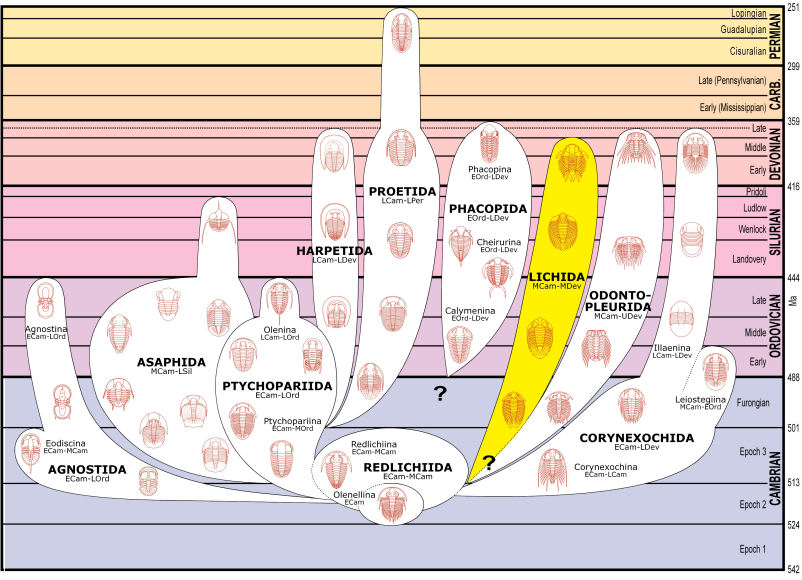click image for
pictorial guide Dicranopeltis
 | ORDER
LICHIDA Moore 1959
last revised 02 September 2011 by S. M. Gon III Introduction: typically spiny with densely granulate or tuberculate exoskeletons and complex glabellar lobation. This is a concept of the order that does not include the families Odontopleuridae and Damesellidae, more recently considered members of a related, but distinct order Odontopleurida. Examine an alternate handling of Order
Lichida that includes the odontopleurids and damsellids.
Cephalon: opisthoparian sutures; glabella broad, large, extending to anterior border, lobation complex with fused lateral and glabellar lobes; eyes holochroal, usually not large; conterminant hypostome, typically large, occupying majority of glabellar area..
Thorax: variable, 10-11 segments, usually spine-tipped.
Pygidium: typically isopygous to macropygous, often longer than wide, often with 3 pairs of furrowed pleurae, typically ending in flat spinose tips.
Other: well developed doublure typically bearing terrace ridges.
Occurrence: Middle Cambrian to Middle Devonian (Givetian)
Superfamilies: Lichoidea. |
Arctinurus

Lichakephalus
 | Superfamily
Lichoidea Introduction: medium to large trilobites, typically surface sculpturing involves two size classes of granules or tubercles.
Cephalon: opisthoparian sutures, glabella broad, extending to anterior border, with unique complex structure (lateral glabellar and occipital lobes fused with each other and with cranidium).
Thorax: 10-11 segments, pleurae initially horizontal, bend retrograde at fulcrum, end in free points.
Pygidium: large, usually flattened, often with 3 pleural pairs of leaflike or spinose structures.
Occurrence: Middle Cambrian to Middle Devonian (Givetian)
Families: Lichakephalidae, Lichidae
Genera: Lichakephalidae: Acidaspidella?, Acidaspides?, Acidaspidina, Archikainella, Belovia, Bestjubella, Brutonia, Colossaspis, Eoacidaspis, Lichakephalus, Lichokephalina, Metaacidaspis, Paraacidaspis, Usoviana.
Lichidae: Acanthopyge (=Euarges), Akantharges, Allolichas, Amphilichas (/Paralichas; /Platymetopus; = Acrolichas; = Kerakephalichas; = Tetralichas), Apatolichas, Arctinurus (/Oncholichas; /Platynotus; /Pterolichas), Autoloxolichas, Borealarges, Ceratarges (/Arges), Ceratolichas, Conolichas (=Cypholichas), Craspedarges, Dicranogmus, Dicranopeltis (=Dicranopeltoides; =Nonix; =Raymondarges; /Trachylichas; =Tsunyilichas), Echinolichas, Eifliarges, Gaspelichas, Hemiarges (=Choneilobarges), Homolichas, Hoplolichas (=Cyranolichas), Hoplolichoides, Jasperia, Leiolichas, Lichas (=Apolichas; =Autolichas), Lobopyge (=Belenopyge), Lyralichas, Mephiarges, Metaleiolichas, Metalichas, Metopolichas (/Metopias; =Holoubkovia; =Macroterolichas), Neolichas, Nipponarges, Ohleum, Oinochoe, Otarozoum, Paraleiolichas, Perunaspis (=Nitidulopyge), Platylichas (=Lingucephalichas), Probolichas, Pseudotupolichas (=Arctinuroides), Radiolichas (=Diplolichas; =Septidenta), Richterarges, Rontrippia, Terataspis, Terranovia, Trimerolichas, Trochurus (=Corydocephalus; =Plusiarges; =Makromuktis), Uralichas (=Bohemolichas; =Platopolichas), Uripes.
|
| ADDITIONAL CLASSIFICATION NOTES FOR LICHIDA:
This treatment distinguishes an Order Lichida (Lichakephalidae+Lichidae) separate from Order Odontopleurida (Odontopleuridae+Damesellidae), although some treatments treat the two as sister clades; both groups bearing tubercles and/or spiny prosopon, complex lobation of the glabella, and certain protaspid similarities suggest the two are ultimately related (e.g., Thomas & Holloway 1988, Fortey 1997). Tripp & Evitt (1981) point to major differences in origin of lobation (lichid lobes arising from the axial furrow, while odontopleurid lobes arise via standard glabella development). Whittington (2002) notes that the Odontopleurida and Lichida differ in several respects, including ornamentation (primarily granules and tubercles in lichids, spines in odontopleurids), extent of ventral calcification (extended doublure with terrace ridges in lichids, not developed in odontopleurids), and hypostome size (larger in lichids), in addition to the glabellar lobation differences. Even if both lichids and odontopleurids are kept in one order (Lichida), it is acknowledged that despite their common origin, they have diverged significantly in the course of their evolution.
The primitive family Lichakephalidae includes genera that have affinities to Lichidae and others to Odontopleuridae, and some workers (e.g., Shergold et al 2000) do not accept the synonymy of Eoacidaspididae and Lichakephalidae. Examination of Cambrian lichakephalid/eoacidaspidid genera Acidaspides and Acidaspidella (Bruton 1983) suggest they should be assigned to Odontopleuridae. This suggests that the Lichakephalidae as listed above is paraphyletic, and not all members should be included in Lichoidea. Primitive Ordovician lichakephalids (e.g., Lichakephalus) bear pygidia that are unlike typical lichids, some being almost styginid-like, however Whittington (2002) suggests that a close relationship between lichids and styginids appears unlikely. In 2005, Pollit et al applied cladistic analysis to the Superfamily Lichoidea (Lichidae+Lichakephalidae) and proposed subfamilial and tribal subdivisions for the family Lichidae. Click here for a cladogram of Lichoid relationships from the Pollit et al 2005 paper (warning, large graphic file).
Expanded and complete genera listings for the families above are based on Jell & Adrain (2003).
Jell, P.A. & J.M. Adrain. 2003. Available generic names for trilobites. Memoirs of the Queensland Museum 48(2):331-553.
Pollit, J.R., R.A. Fortey & M.A Wills. 2005. Systematics of the Trilobite families Lichidae Hawle & Corda, 1847 and Lichakephalidae Tripp, 1957: The application of Bayesian inference to morphological data. J.
Syst. Pal. 3(3):225-41.
Shergold, J.H., R. Feist & D. Vizcaino. 2000. Early Late Cambrian trilobites of Australo-Sinian aspect from the Montagne Noir, Southern France. Palaeontology 43(4):599-632.
Thomas A.T. and D.J. Holloway. 1988. Classification and phylogeny of the trilobite order Lichida. Phil. Trans. Royal Soc. London 321:179-262.
Tripp, R. P. & W. R. Evitt. 1981. Silicified Lichidae from the Middle Ordovician of Virginia. Geological
Magazine, 118:665–677.
Whittington, H.B. 2002. Lichidae (Trilobita): Morphology and classification. J. Paleontology 76(2):306-20. |






